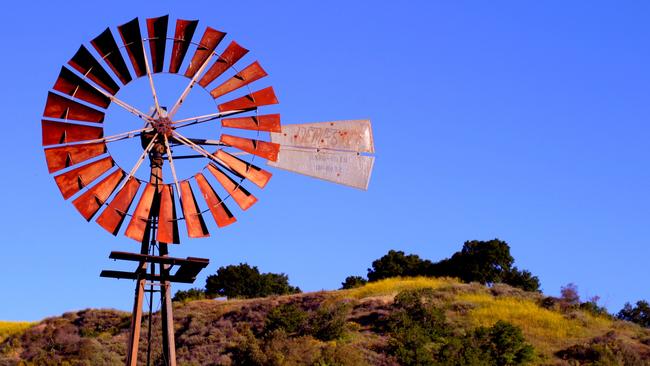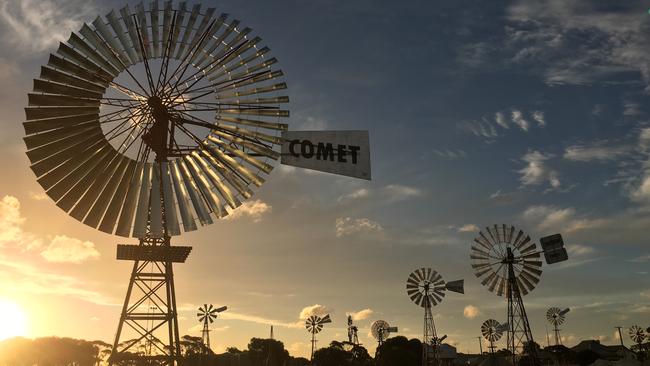These emblems of country Australia are disappearing
Where are the windmills? These giant steel flowers on their Eiffel struts dotted our stock routes and paddocks for a century and a half.

Where are the windmills? It struck me on a recent drive on the disappearing back roads heading into a town too far away. This was windmill land, but where were the giant steel flowers on their Eiffel struts that have dotted our stock routes and paddocks for a century and a half; the muscular symbols of the great settler thrust? Those ubiquitous icons that once populated the length and breadth of our land are disappearing, almost gone.
It was in Victorian times that engineers first discovered deep reserves of underground water in the Great Artesian Basin, which stretches across a fifth of our continent. Cattle and sheep had previously been confined to creek and river frontages, but when bore water was discovered a plethora of new opportunities opened up. Onward and outward the pastoralists now marched, clearing and colonising. And so began the great reach of the iron towers, those lifelines of rural Australia.
The fan-wheeled windmills were initially imported from the US, but we were soon making our own. In 1871 the Southern Cross Group was set up, creating wooden windmills, at first, as an inexpensive way of watering stock off the beaten track. It was so successful that Ireland was soon importing Australian machines to draw water from their peat bogs. An early name for the Southern Cross windmill was the “Little Wonder” – and what a marvel it was.
But was this alien structure reaching high into the sky loathed by Indigenous people, signposting as it did the will of the settler who ruthlessly, methodically, cleared country? Sydney based poet Eileen Chong wrote in a recent poem, “the arms of the windmills turning: the days are passing strange”. How passing strange those iron giants must have seemed to Indigenous people in the 1800s (they had known about the underground water for thousands of years, of course.)
And now those windmills are almost gone; the workhorses of farmers that were buggers to maintain, lopping off fingers and arms and occasionally killing the brave who maintained them amid all those moving parts. The grey blades were curved to catch the wind but summer storms could blow off them off and pumps would leak with alarming regularity.
If you’re nostalgic for a windmill there’s a garden of steel flowers on the edge of the Nullarbor, in South Australia’s Penong. Two locals, Bob Oates and Tim Hardy, have set up a museum by the highway that preserves roughly 20 of our old windmills, including the mighty Bruce, the largest in Australia (its dimensions are a state secret in case someone pipes up and steals its crown). “Another bloody windmill, here we go again,” Oates’ wife Jill told the ABC. “They love it, but we just quite often shake our heads and curse and smile nicely.”

I recently drove through denuded windmill country in the early morning, with all the windows down, to catch the smell like no other. It’s that smell of inland Australia at the extremities of its days, a scent that lured me home after 14 years in Blighty’s dampness. It’s the smell of the earth rested overnight and now opened to the air and the light, and, well, is there any scent more beautiful? No.
But where were the windmills, I wondered, those iron giants bestriding the land from all the country drives of my childhood. Those thrusting symbols of settler vanquishment were gone. What’s left is dramatically cleared land, and sheep the colour of the grass they’re grazing on, and skeleton gums contorting dead branches into a wide, stretched sky. The windmills are slowly being replaced by solar pumps, which of course are safer, as well as more efficient and reliable. But despite what they symbolise, I miss the old windmills. Thank goodness for Bob and Tim.
nikki.theaustralian@gmail.com







To join the conversation, please log in. Don't have an account? Register
Join the conversation, you are commenting as Logout